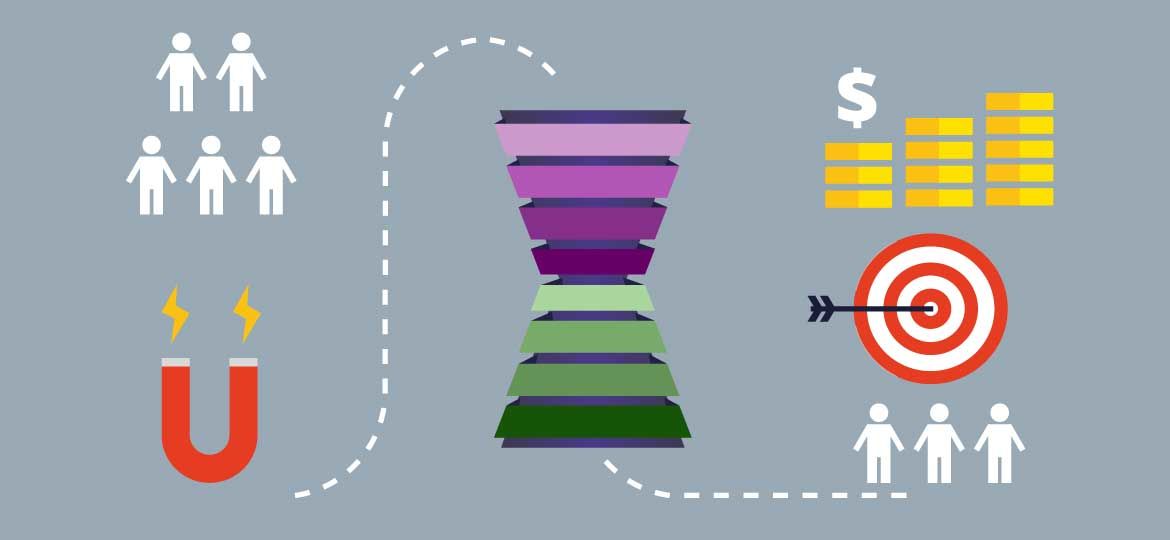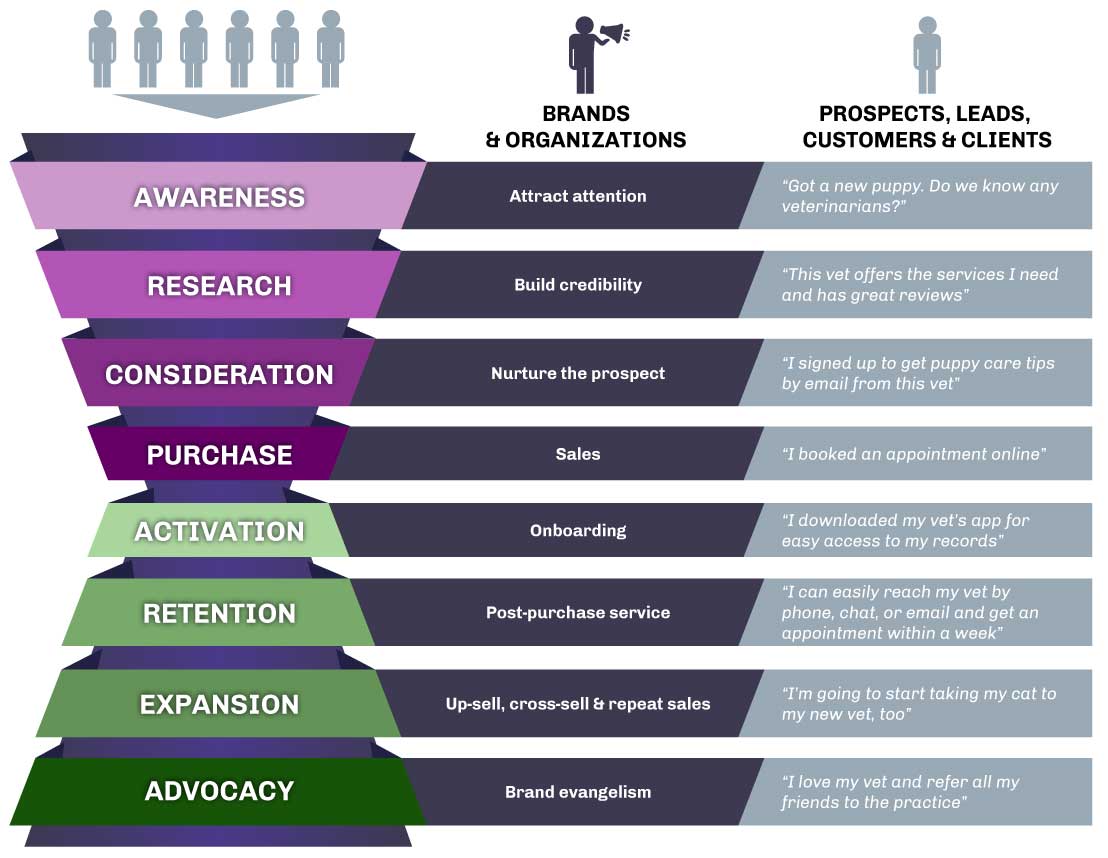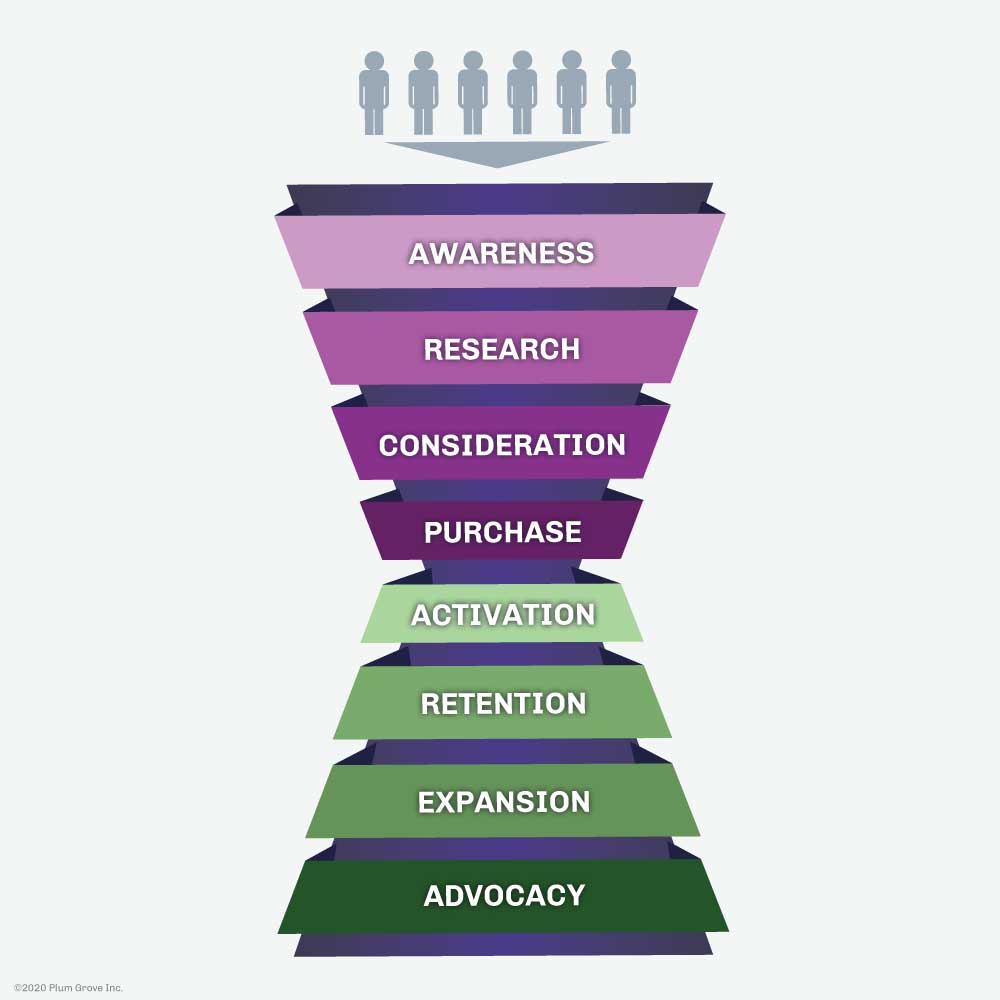
The days of relying solely on sales and sales tactics to attract new customers or clients are long gone. Today’s savvy consumer is much better educated than the consumer of yesteryear. Consumers today have the tools and resources at their fingertips (literally!) for better research and education about the products and services they’re interested in, and they hate being sold to. Consumers see more than 5,000 ads a day, but are more cautious to buy. This is why it’s imperative to have an effective marketing funnel strategy for your business.
What is a Marketing Hourglass?
Like a funnel, marketers rely on the marketing hourglass to position your brand in front of your target audience and nurture your prospects and leads through the buying journey, answering questions and presenting solutions to problems on their path to purchase. However, unlike the traditional sales funnel, the marketing hourglass guides the customer through the post-purchase process to ensure they are thoroughly delighted with their purchase experience so they remain loyal customers and, eventually, become advocates for your brand. Even the most successful brands in the world, like Apple and Coca-Cola, use the marketing hourglass to, not only, attract customers but also to recruit brand evangelists for life.
The marketing hourglass details the different steps customers typically make from the moment they discover your brand to their first purchase and beyond. Plum Grove’s detailed marketing hourglass and buyer journey is a process that embraces leads and clients every step of the way to promote business growth and build your brand.

- Awareness – Through various marketing channels and platforms, whether that be advertising, direct mail, social media, etc., potential customers or clients become aware of your brand.
- Research – Prospects learn more about your brand, products or services and the solutions you offer. Your brand begins to differentiate itself from competitors.
- Consideration – Your brand has made the short list of brands being considered, but the prospect needs more in-depth information. This could come from a website visit comparing your products with similar products or a promotional incentive, like a coupon.
- Purchase – A prospect becomes a customer and makes a purchase. This is the moment of truth, but the customer is only halfway through the marketing hourglass.
- Activation – A positive onboarding experience confirms with your customers that they made the right purchase selection. The relationship between the customer and brand strengthens.
- Retention – Take that extra step to ensure customers are satisfied with their purchase and delighted with the brand. Successful retention means keeping customers engaged, happy and return purchasing.
- Expansion – Connect with customers, learn from them, up-sell, and cross-sell. Show them you care and their feedback is important to you. They become part of the brand evolution.
- Advocacy – Consumers that had a positive experience with a brand are much more likely to recommend the company to others. Your customers become loyal evangelists for your brand.

Strategies & Tactics
Top of the Funnel – At the top of the funnel, prospects are in the awareness and education phase. They are your largest qualified audience but are unaware of your brand or unaware of a need for your brand. The key to connecting with these buyers is to make them aware of your product and the benefits it offers.
Marketing tactics that are relatively inexpensive and draw in a wide audience are recommended for this stage, including Google ads, direct mail marketing, social media marketing, display ads and search engine optimization (SEO). The majority of consumer research happens in this stage, and the discovery loop takes them back and forth through different mediums. This is the perfect opportunity to demonstrate why your brand is different than the competitors and educate your audience on the features of your products and services.
Middle of the Funnel – Once your target audience has educated themselves on the available solutions in the market and what your brand has to offer they move into the consideration, purchase and adoption stages. This stage is often under-served, or given little after thought. As a prospect nears the point of purchase, new questions, concerns, or objections can materialize. In order to get over that hump, customers need support to feel confident in how your brand will ensure a smooth transition. Brands need to walk the consumer through to conversion with a simple and risk-free checkout process and smooth onboarding to ensure a delightful purchasing experience.
For this stage, some of the marketing tactics that function the best include an educated and accessible customer support and sales team, effective website design, email marketing and display marketing. By gathering contact information, you can offer a discount or free shipping promotion, as well as customer support and product documentation. Remarketing ads can target consumers who’ve browsed your site with additional product offers or discounts to keep them coming back.
Bottom of the Funnel – Last but certainly not least, is the bottom of the funnel, which is often referred to as loyalty portion of the funnel. This stage is when customers become evangelists for your brand. Through careful guidance through the marketing hourglass, your brand and products have earned the trust of your customers with an enjoyable buying process. With continued engagement and strong customer support, your brand will be able to keep those customers in the marketing hourglass and continue to purchase, up-sell and cross-sell additional products.
In the loyalty stage, employ campaigns that bring back and retain existing and past customers. Tactics including email and text marketing, promotional product gifts, direct mail and social media marketing. Create touchpoints that engage the customer, while leveraging loyalty programs and other promotional incentives to entice the customer to repurchase.
Conclusion
Today’s consumer is better informed and far more savvy than the consumers of yesterday. Brands have to get in front of the right audience at the right time with the right message to nurture prospects through the sale. Post-purchase tactics help solidify relationships and engage clients with new opportunities. A fully developed marketing hourglass assures your brand supports the customer journey every step of the way, and turns out brand evangelists that help support your future business growth.

